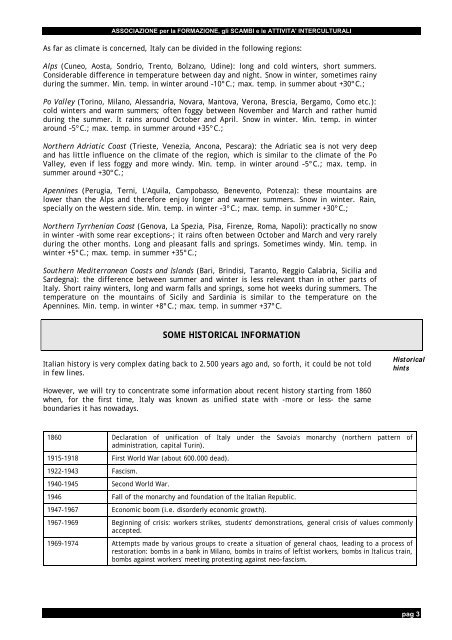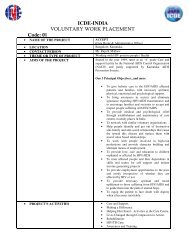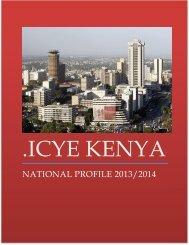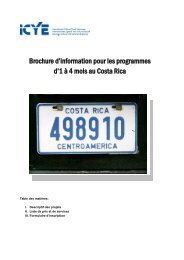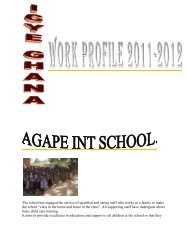list of subjects - (ICYE) (en)
list of subjects - (ICYE) (en)
list of subjects - (ICYE) (en)
You also want an ePaper? Increase the reach of your titles
YUMPU automatically turns print PDFs into web optimized ePapers that Google loves.
ASSOCIAZIONE per la FORMAZIONE, gli SCAMBI e le ATTIVITA' INTERCULTURALI<br />
As far as climate is concerned, Italy can be divided in the following regions:<br />
Alps (Cuneo, Aosta, Sondrio, Tr<strong>en</strong>to, Bolzano, Udine): long and cold winters, short summers.<br />
Considerable differ<strong>en</strong>ce in temperature betwe<strong>en</strong> day and night. Snow in winter, sometimes rainy<br />
during the summer. Min. temp. in winter around –10°C.; max. temp. in summer about +30°C.;<br />
Po Valley (Torino, Milano, Alessandria, Novara, Mantova, Verona, Brescia, Bergamo, Como etc.):<br />
cold winters and warm summers; <strong>of</strong>t<strong>en</strong> foggy betwe<strong>en</strong> November and March and rather humid<br />
during the summer. It rains around October and April. Snow in winter. Min. temp. in winter<br />
around –5°C.; max. temp. in summer around +35°C.;<br />
Northern Adriatic Coast (Trieste, V<strong>en</strong>ezia, Ancona, Pescara): the Adriatic sea is not very deep<br />
and has little influ<strong>en</strong>ce on the climate <strong>of</strong> the region, which is similar to the climate <strong>of</strong> the Po<br />
Valley, ev<strong>en</strong> if less foggy and more windy. Min. temp. in winter around –5°C.; max. temp. in<br />
summer around +30°C.;<br />
Ap<strong>en</strong>nines (Perugia, Terni, L'Aquila, Campobasso, B<strong>en</strong>ev<strong>en</strong>to, Pot<strong>en</strong>za): these mountains are<br />
lower than the Alps and therefore <strong>en</strong>joy longer and warmer summers. Snow in winter. Rain,<br />
specially on the western side. Min. temp. in winter –3°C.; max. temp. in summer +30°C.;<br />
Northern Tyrrh<strong>en</strong>ian Coast (G<strong>en</strong>ova, La Spezia, Pisa, Fir<strong>en</strong>ze, Roma, Napoli): practically no snow<br />
in winter -with some rear exceptions-; it rains <strong>of</strong>t<strong>en</strong> betwe<strong>en</strong> October and March and very rarely<br />
during the other months. Long and pleasant falls and springs. Sometimes windy. Min. temp. in<br />
winter +5°C.; max. temp. in summer +35°C.;<br />
Southern Mediterranean Coasts and Islands (Bari, Brindisi, Taranto, Reggio Calabria, Sicilia and<br />
Sardegna): the differ<strong>en</strong>ce betwe<strong>en</strong> summer and winter is less relevant than in other parts <strong>of</strong><br />
Italy. Short rainy winters, long and warm falls and springs, some hot weeks during summers. The<br />
temperature on the mountains <strong>of</strong> Sicily and Sardinia is similar to the temperature on the<br />
Ap<strong>en</strong>nines. Min. temp. in winter +8°C.; max. temp. in summer +37°C.<br />
SOME HISTORICAL INFORMATION<br />
Italian history is very complex dating back to 2.500 years ago and, so forth, it could be not told<br />
in few lines.<br />
However, we will try to conc<strong>en</strong>trate some information about rec<strong>en</strong>t history starting from 1860<br />
wh<strong>en</strong>, for the first time, Italy was known as unified state with -more or less- the same<br />
boundaries it has nowadays.<br />
1860 Declaration <strong>of</strong> unification <strong>of</strong> Italy under the Savoia's monarchy (northern pattern <strong>of</strong><br />
administration, capital Turin).<br />
1915-1918 First World War (about 600.000 dead).<br />
1922-1943 Fascism.<br />
1940-1945 Second World War.<br />
1946 Fall <strong>of</strong> the monarchy and foundation <strong>of</strong> the Italian Republic.<br />
1947-1967 Economic boom (i.e. disorderly economic growth).<br />
Historical<br />
hints<br />
1967-1969 Beginning <strong>of</strong> crisis: workers strikes, stud<strong>en</strong>ts' demonstrations, g<strong>en</strong>eral crisis <strong>of</strong> values commonly<br />
accepted.<br />
1969-1974 Attempts made by various groups to create a situation <strong>of</strong> g<strong>en</strong>eral chaos, leading to a process <strong>of</strong><br />
restoration: bombs in a bank in Milano, bombs in trains <strong>of</strong> leftist workers, bombs in Italicus train,<br />
bombs against workers' meeting protesting against neo-fascism.<br />
pag 3


